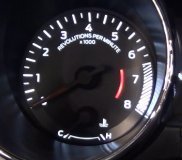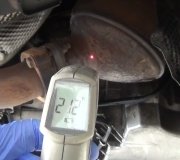Symptom:
When engine is warm it starts to buck almost like the key is turned off under high load at low rpm; Example would be climbing a hill in OD with your foot almost to the floor. If you allow the transmission to downshift it goes like mad without any issues.
Runs good when cold and will spin the tires from a dead stop when warm.
Other symptom is that idles a bit rough on warm restart and never really fully recovers. Also the fuel consumption is 13 if I drive it like I stole it or 13.5 if I take it real easy.
I was told that it had 105K miles on it when I bought it, but I think it was 205K, but have driven it for 5K since and performed many repairs to bring it up to snuff as there were many drivability issues when I first bought it, but now I am down to this one.
I have invested in the Ford Service manual for this vehicle and...
Parts replaced:
Plugs (old ones were good, except #8 was excessively worn)
Wires
Coil
Distributor (including ICM and pickup)
MAP Sensor
TPS Sensor
ECT Sensor
PCM
O2 sensor
Muffler and tailpipe.
Both fuel pumps & filter (tank had been replaced and was clean as a whistle)
Diagnostic tests:
Steady and high manifold vacuum at idle – good valves / no leaks.
Backpressure test using manifold vacuum indicated no backpressure in exhaust.
Fuel pressure at rail in limits with no leak down.
Timing is good.
Removing the spout jumper has no effect.
Retarding the ignition timing had no effect – eliminating the possibility of knock tripping the knock sensor.
EGR valve responds properly to vacuum inputs; EGR valve itself is clean as were the ports.
Will occasionally get a check engine on hard acceleration with a cold engine.
No codes are stored however.
During KOER I’ll get:
Idle speed too high
Idle speed too low
Thermactor system failure (I am not concerned about air quality at this time).
Full Throttle test failure (77). The ford manual indicates that this is a PCM issue. I replaced the PCM and the code remains.
Idle air control motor passed the ford tests.
No manifold leaks were found.
I had to add one quart of oil after 3,500 miles. I think the 302 is in pretty good shape mechanically but I haven’t run a compression test.
I think I am down to having to pull the intake to gain access to the PCV valve, knock sensor and fuel injectors. I don’t believe the PCV valve can cause the high speed issue, but know they can foul up the idle.
I’m suspecting that I have one or more defective fuel injectors; I think this would cause fuel starvation under extreme loads and the PCM would compensate (incorrectly) by enriching the mixture. If the injector is thermally defective then that could explain why the condition gets worse as the engine warms up – especially after a hot soak
How does one find which injector is bad when 4 of them fire at the same time?
Am I missing something obvious?
Thanks,
Bill
SPONSORED LINKS
Tuesday, October 30th, 2007 AT 5:32 PM



